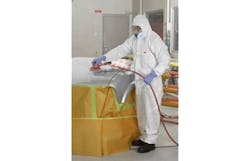It often surprises leaders and technicians how complex cleanroom challenges can become.
Technicians see that equipment runs at different levels every day, so changes can occur based on ambient conditions and the demand on the system.
It takes experience to analyze various changes and to be able to determine which are indicative of deeper issues and which are the result of a small change in operating or ambient conditions.
The type of precision is critical in the clean-room environment, where equipment and environmental conditions are closely monitored to maintain the strict level of sterility required for special operations and data collection.
Here are insights into some of the most complex challenges.
Humidification
Keeping the humidity levels exactly right in a clean room can be a big challenge.
Maintaining the ideal humidity is a matter of controlling the environment to strict tolerances, and using specific solutions to ensure the target humidity is maintained. If the environment in the room is too humid, there can be negative reactions to the clean-room chemicals. If it's too dry, electrostatic charges can develop on the equipment or the people walking through the space, generating high voltage discharges.
In one example, a technician was using a vacuum cleaner to clean debris out of a tool and the vacuum hose became charged. The person holding the vacuum had transferred the charge over to the metal tool, creating a high-voltage charge against it. The debris going through the vacuum hose was not a conductive material, so as the air went across it, the charge transferred onto the hose.
The solution, in that case, was to select a hose with some conductive properties and keep it grounded to avoid carrying a charge through the hose.
The “bunny suits” that technicians wear in the clean room can also create a shock hazard if they are made of certain materials, like polyester. Controlling the humidity is a factor in avoiding those charges, both within the suit itself—through a built-in grounding system that dissipates the charge before it can build up—and in the room, taking special consideration for the tooling and electronics in the room.
There are a Few Key Solutions to Control the Humidity
Injecting water into the air stream is a simple way of adding humidity to the room. Reducing the humidity can be more challenging, but there are two common approaches. The first is to add a chilled or super-chilled water system that condenses the water out of the air. The other is to use a desiccant dehumidifier system. Each of these has advantages and disadvantages and which to use and when depends on the owner’s preferences.
In many larger-scale operations, the desiccant system proves too maintenance-intensive as it must be replaced regularly as moisture is absorbed. Removing the saturated desiccant material, drying it, and replacing it is a long cycle. To control it, more air can be directed through the desiccant part of the system, bypassing air around it to avoid taking moisture out, but this control is not as tight as a chilled water system.
A chilled water system uses coils and is managed with a control valve requiring less maintenance and supervision, but it comes with a higher utility cost. Leaders must weigh the two options and choose whichever is best to meet the specific needs of their facility.
With either of these solutions, the key to optimization is control.
Making sure that the end product meets the desired goals, and applying the appropriate controls to achieve that. Ideally, systems should trim unnecessary moisture directly from the ambient air to reach the goal humidity, from 70% humidity directly down to 40%, for example. What often happens instead is the 70% air is supersaturated as it enters the air handler, bringing it up to 100% humidity and then reducing it back down to the desired 40%.
This is the easiest way to achieve a consistent result, and it requires fewer controls to go from 100% to 40% every time, versus calibrating from the ambient humidity—whatever percentage that may be—down to the target humidity. While this system is less efficient, it does require fewer variables, has a less robust control structure, and makes it easier to respond quickly to changes in ambient humidity.
If the starting humidity is always 100% in the air handler, it doesn’t matter whether the outside air is humid or dry. In cases where there is less supervision available, fewer controls in place, or erratic weather patterns, such a solution might be ideal for the conditions.
Humidity is not the only condition to consider, either. If humidity is fairly consistent within the structure, leaders may place the emphasis on controlling other elements.











